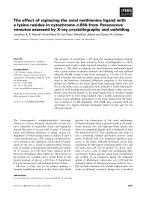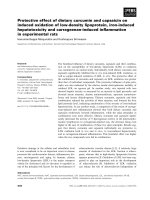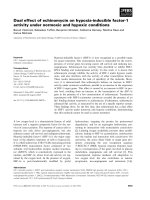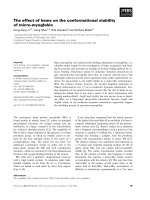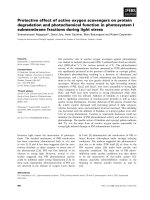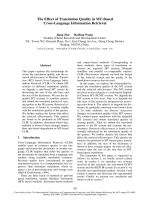Báo cáo khoa học: "he Effect of Transdermal Delivery of Fentanyl on Activity in Growing Pigs" pps
Bạn đang xem bản rút gọn của tài liệu. Xem và tải ngay bản đầy đủ của tài liệu tại đây (111.1 KB, 9 trang )
Malavasi LM, Augustsson H, Jensen-Waern M, Nyman G: The effect of transder-
mal delivery of fentanyl on activity in growing pigs. Acta vet. scand. 2005, 46, 149-
157. – Recently, decreased activity levels have been observed in pigs treated postopera-
tively with transdermal delivery of fentanyl (TD-fentanyl) after isoflurane anaesthesia.
Whether the change in behaviour is related to opioid-induced sedation or to insufficient
pain relief remains to be investigated. This study was therefore undertaken to evaluate
the effect of TD-fentanyl 50 µg h
-1
on the activity level with and without isoflurane
anaesthesia. Eight pigs (25.4 ± 5.2 kg) were submitted to a cross-over study and given
two treatments; 1) fentanyl patch applied after 30 minutes of anaesthesia (treatment
A/F) and 2) fentanyl patch without anaesthesia (treatment F). The pigs' behaviour was
observed from a video recording instantaneously every 10 minutes for 24 h before treat-
ments and up to 72 h after the patch attachment. Venous blood samples were taken 1, 6,
12, 24, 48 and 72 h after the patch application. The behaviour recordings showed that
TD-fentanyl did not produce sedation in any pig. No differences were found between the
two treatments in activity level, weight gain or serum fentanyl concentration. This con-
centration measured after 24 h was 0.27 ± 0.11 ng ml
-1
and 0.47 ± 0.40 ng ml
-1
in the
A/F and F group, respectively.
In conclusion, transdermal delivery of 50 µg h
-1
fentanyl did not cause inactivity in
growing pigs. However, the large variations in serum fentanyl concentration indicate
that drug absorption from transdermal patches is unpredictable and sometimes deficient.
swine; analgesia; opioids; patch; behaviour; pain; sedation; activity
Acta vet. scand. 2005, 46, 149-157.
Acta vet. scand. vol. 46 no. 3, 2005
The Effect of Transdermal Delivery of Fentanyl on
Activity in Growing Pigs
By L. M. Malavasi, H. Augustsson, M. Jensen-Waern, G. Nyman
Department of Clinical Sciences, Faculty of Veterinary Medicine and Animal Science, Swedish University of
Agricultural Sciences, Uppsala, Sweden.
Introduction
Opioids have short serum half-lives in pigs,
leading to a need for repeated restraint and drug
administration to achieve adequate analgesia
(Harvey-Clark et al. 2000). Both restraint and
injections are potential acute stressors in pigs
and may result in physiological and behavioural
changes. These changes can influence animal
research outcomes, as stress factors have been
reported to cause a rise in plasma cate-
cholamines (i.e. epinephrine and norepine-
phrine), ß-endorphin and cortisol in pigs
(Roozen et al. 1995, Gonyou 1996). It is there-
fore important to study different methods to ad-
minister drugs to pigs in an attempt to decrease
the number of restraints and the need for animal
handling during the postoperative period.
In veterinary medicine, the main routes of drug
administration are oral, intramuscular, subcuta-
neous and intravenous. Recently, transdermal
patches have been considered as an alternative
method of drug application in animals (Riviere
& Papich 2001, Malavasi et al. 2004). One of
the advantages of transdermal patches is that
they can minimise the risk of adverse effects of
the drug by decreasing large fluctuations in
plasma concentration (Carroll et al. 1999).
Fentanyl is a synthetic opioid at least 75-100
times more potent than morphine and has been
selected over other opioids for use as a trans-
dermal delivery system both for pre-emptive
and postoperative analgesia in humans (Bowdle
1998, France et al. 1998), dogs (Rang et al.
1996, Pettifer & Hosgood 2004), cats (Egger et
al. 2003), pigs (Szeit, Riggs and Harvey-Clark
1996, Harvey-Clark et al. 2000), goats (Carroll
et al. 1999) and horses (Thomasy et al. 2004).
Also, efficient transdermal delivery of fentanyl
(TD-fentanyl) in pigs can provide continuous
and systemic delivery of fentanyl up to three
days per patch application (Harvey-Clark et al.
2000, Wilkinson et al. 2001, Thomasy et al.
2004). However, there is still a lack of informa-
tion about the optimal dosing and the analgesic
and behavioural effects of fentanyl when given
as a transdermal patch to pigs (Sanford et al.
1986, Wilkinson et al. 2001). In an attempt to
elucidate these issues, Malavasi and co-workers
(2004) studied the effect of TD-fentanyl on the
activity level in pigs after abdominal surgery. In
addition to the analgesia provided with medeto-
midine and tiletamine/zolazepam anaesthesia,
fentanyl patches were used postoperatively.
During this period, the activity level decreased
significantly compared to preoperative record-
ings. This observed inactivity could either be
associated with sedation produced by the opi-
oid or to insufficient pain relief. Fentanyl is a
full opioid agonist that acts mainly on mu-re-
ceptors, which are responsible for producing
analgesia as well as having side effects e.g. res-
piratory depression (Nolan 2001, Martin 1985,
Rang et al. 1996, Branson & Gross 2001). Ad-
ditionally, fentanyl is known to produce narco-
sis in dogs, rabbits, rats and primates. In con-
trast, excitement is reported in horses and mice
(Martin 1985).
In the present study we have tested the hypoth-
esis that growing pigs treated with a fentanyl
patch delivering a dose of 50 µg h
-1
will display
inactivity due to the opioid effect. Further, there
is a possibility that inhalation anaesthesia can
influence the serum fentanyl concentration (Eg-
ger et al. 2003, Pettifer & Hosgood 2004).
Thus, the aim of the present study was to video-
record and analyse behaviour pattern, and assay
serum fentanyl by gas chromatography in a lon-
gitudinal cross-over study. It was considered
that any interaction between fentanyl and
isoflurane, as observed previously in studies on
dogs and cats (Egger et al. 2003, Pettifer &
Hosgood 2004), could be identified in this way.
Material and Methods
Animals
Eight crossbreed pigs (Swedish Landrace x
Yorkshire) from a conventional gilt-producing
herd were purchased from a farm which has
been under our swine specialist supervision for
many years. On arrival, the pigs were five
weeks old and clinically healthy, and there were
an equal number of males and females. They
were housed at the Department of Clinical Sci-
ences, in individual pens (approximately 3.5 m
2
each) with a solid concrete floor and straw as
bedding. They were kept within sight and sound
of one another with a light regime of 8 h
light/16 h dark. The pigs were fed twice daily
(8:00 h and 15:00 h) with a commercial finisher
diet (Singel Flex
®
, Odal, Sweden) and had free
access to water. They were allowed a five-week
acclimatisation period. When the experiment
started the animals weighed 25.4 ± 5.2 kg
(mean ± SD).
The experimental protocol was approved by the
Ethical Committee for Animal Experiments,
Uppsala, Sweden.
Anaesthesia and analgesia
Before anaesthesia the pigs were fasted for 12 h
but supplied with water ad libitum. The total
duration of the experiment was three weeks:
two weeks of treatment (week 1 and week 3)
150 L. M. Malavasi et al.
Acta vet. scand. vol. 46 no. 3, 2005
and one week of washout in between (week 2).
The animals were randomly chosen in pairs for
a cross-over test in which the same animal
would receive one treatment during week 1 and
the other treatment during week 3. The treat-
ments with TD-fentanyl were: 1) one fentanyl
patch (50 µg h
-1
; Durogesic, Janssen-Cilag AB,
Sollentuna, Sweden) for 60 h applied after 30
minutes of general anaesthesia (treatment A/F);
and 2) one fentanyl patch for 60 h without gen-
eral anaesthesia (treatment F). The plasters
were attached to the skin behind the ear. This
skin area was shaved with care to avoid abrad-
ing the skin but it was not washed prior to at-
tachment of the patch. The attachment proce-
dure was in accordance with the manufacture's
recommendations for humans. In order to pro-
tect the patches and prevent their being rubbed
off, a piece of canvas was sutured onto the skin
and checked at least twice a day. In the awake
pigs, a local anaesthetic (EMLA cream; As-
traZeneca Läkemedel AB, Södertäjle, Sweden)
was applied to the suture sites on the skin ap-
proximately 60 minutes prior to the suturing of
the canvas.
Anaesthesia was induced with a combination
of medetomidine hydrochloride at a dosage of
0.05 mg kg
-1
(Domitor
®
vet 1 mg ml
-1
; Orion,
Espoo, Finland) and tiletamine-zolazepam (Zo-
letil forte vet; Virbac, Carros, France) at a
dosage of 5 mg kg
-1
(2.5 mg kg
-1
of zolazepam
and 2.5 mg kg
-1
of tilazamine), given intramus-
cularly. Ten minutes after injection of the anaes-
thetic drug, the animal was intubated with an
endotracheal tube 6-8 mm in diameter for
maintenance of inhalation anaesthesia with 1%
isoflurane during 30 minutes (Isoflo™vet;
Schering-Plough, Kent, UK), supplied with
oxygen and air (vaporizer Isotec 5; Datex-
Ohmeda, Helsinki, Finland). At the end of the
general anaesthesia the fentanyl patch was at-
tached to the skin of the pig.
During the fentanyl patch treatments, all pigs
were clinically examined at least twice a day,
with special regard to any physiological side ef-
fects or manifestations of narcotisation.
Fentanyl measurement
Blood samples (4 mL) were collected from the
external jugular vein into vacutainer tubes
without additives at six different time points: 1,
6, 12, 24, 48 and 72 h after application of the
fentanyl patch. The animals were restrained
with a nose twitch during the blood sampling
procedure. Serum was separated by centrifuga-
tion at + 4ºC within ten minutes after blood
sampling, and stored at - 70ºC until analysed at
the University Hospital of Linköping. The
serum fentanyl concentration was measured by
gas chromatography with mass-selective detec-
tion as described by Szeit et al. (1996). Fentanyl
was extracted from 1 mL of serum by using 2-
octanol, and deuterium-labelled fentanyl was
used as internal standard (Fentanyl-D5). This
method was calibrated to detect fentanyl con-
centrations above 0.05 ng ml
-1
.
Ethogram
An ethogram based on earlier observations of
four pigs of the same age, breed and weight,
was used (Malavasi et al. 2004). The animal's
spontaneous behaviour was recorded and the
different activities were divided into active and
inactive behaviours. The following behaviours
were regarded as active: standing up, walking,
running, jumping, interacting with blanket or
straw, rooting, eating and drinking. The inactive
behaviours comprised: lying down quietly, ly-
ing down agitatedly and sitting position.
To minimize human disturbance on the pig be-
haviour, animal care taking, feeding and video-
tape changing were executed daily at same time
(8:00 h and 15:00 h).
Behavioural recordings
Each animal was videotaped for a total of 168
The effect of transdermal delivery of fentanyl on activity in growing pigs 151
Acta vet. scand. vol. 46 no. 3, 2005
hours. The recordings covered the periods 24
hours before the treatments and 72 hours after
each treatment, beginning when the animal was
left alone in its pen after completion of the
treatment. Two black and white video cameras
with a wide-angle lens (Computar CE IP66,
Italy) were positioned approximately one meter
in front of each pen. Behaviour was recorded
with a time-lapse video cassette recorder (Pana-
sonic, AG-TL350) and a video multiplexer
(Panasonic, WJ-FS409). The picture-sampling
interval was 0.18 second, and the time code in
hours/minutes/seconds was recorded on the
tape.
A researcher, blinded to the treatments,
watched all videotapes and manually recorded
the pig's behaviour, using instantaneous sam-
pling at intervals of ten minutes troughout the
168 h period.
Body weight
The pigs were weighed before the treatments
and once a day for three consecutive days after
the treatments. The weighing procedure was
performed before the first feeding time and a
wooden box was used to restrain the pigs. The
box was positioned in front of the door of the
animal pen and the pig was oriented to walk to
the inside of the box. When the pig had entered
the box this was lifted onto a digital scale and
the body weight was measured. The entire pro-
cedure was carefully executed to avoid exces-
sive animal stress.
Statistical analysis
The data from the pre-treatment period were
used as control data. The activity/inactivity lev-
els and each specific activity were analysed by
repeated measurements ANOVA. The weight
gains were calculated as the difference between
the pre-treatment value and the values obtained
24, 48 and 72 hours after the application of the
patch and analysed with repeated measure-
ments ANOVA. Throughout the study, serum
fentanyl values were analysed by a General Lin-
ear Model. All results were produced by statis-
tical software (Minitab, Inc., Coventry, UK.)
and presented as mean values ± SD. Statistical
significance was defined as p<0.05.
152 L. M. Malavasi et al.
Acta vet. scand. vol. 46 no. 3, 2005
ACTIVE BEHAVIOUR
0
10
20
30
40
50
pre-
treatment
24h 48h 72h
%
treatment A/F
treatment F
Figure 1. Percentage (mean ± SD) numbers of observations of active behaviours in pigs treated with a fentanyl
patch with (treatment A/F) and without isoflurane anaesthesia (treatment F), during the pre-treatment day and
24, 48 and 72 h after application of the patch. (n= 8)
Results
Behavioural observations
The activity level in all eight pigs during the
pre-treatment period was 27 ± 6%. Throughout
the experiment, comprising week 1 and week 3,
pigs from treatment group A/F had an activity
level of 27 ± 0.2% and pigs from treatment
group F had an activity level of 27 ± 2%. No
significant difference in activity level was
found between treatment groups or between
time points (Fig. 1). Among all pigs treated, the
TD-fentanyl did not induce any signs of narco-
tisation. The percentage of each specific activ-
ity did not differ significantly between groups
or between time points. For instance, eating be-
haviour in treatment group A/F was 10 ± 3% on
the pre-treatment day, 9 ± 2% 24 h after the
patch application, 8 ± 2% at 48 h and 8 ± 2% at
72 h. In treatment group F, the eating behaviour
was 10 ± 3% on the pre-treatment day, 9 ± 3%
24 h after the patch application, 8 ± 3% at 48 h
and 7 ± 12% at 72 h.
Both treatment groups showed a similar weight
gain throughout the experiment.
Fentanyl measurement
There were no significant differences in mean
serum fentanyl concentrations between the
treatment groups as shown in Figure 2. The
serum fentanyl range 24 h after the patch appli-
cation in treatment group A/F was 0.09-0.46 ng
mL
-1
and in treatment group F 0.17-1.00 ng
mL
-1
. Transdermal delivery of fentanyl resulted
in large interindividual differences in serum
concentrations (Fig.3). Pig 5 was excluded
from this analysis because of unreliable serum
values.
The effect of transdermal delivery of fentanyl on activity in growing pigs 153
Acta vet. scand. vol. 46 no. 3, 2005
SERUM FENTANYL CONCENTRATION
0
0,2
0,4
0,6
0,8
1
1,2
1 h 6 h 12 h 24 h 48 h 72 h
treatment A/P
treatment P
Patch off
1.2
1.0
0.8
0.6
0.4
0.2
ng/mL
Ƈ Treatment A/F
Ƒ Treatment F
Figure 2. Mean serum fentanyl concentrations ± SD (ng/mL) in pigs treated with a fentanyl patch with (treat-
ment A/F) and without isoflurane anaesthesia (treatment F). Values obtained 1, 6, 12, 24, 48 and 72 hours after
the patch application are shown. The fentanyl plasters were taken off 60 hours after application. (n= 8)
Discussion
Transdermal delivery of fentanyl at 50 µg h
-1
in
pigs weighing 25 kg was not associated with
any measurable behavioural consequences. All
pigs displayed a constant activity level of ap-
proximately 27%, which was significantly
higher than the activity levels of 16% in pigs
treated with TD-fentanyl postoperatively (Ma-
lavasi et al. 2004). In that study the activity
level of pigs treated with postoperative TD-fen-
tanyl as additional analgesia to medetomidine
and tiletamine/zolazepam was compared with
the behaviour recorded during the pre-operative
day. The lower activity level could thus be re-
154 L. M. Malavasi et al.
Acta vet. scand. vol. 46 no. 3, 2005
treatment A/P: fentanyl with anaesthesia
0
0,1
0,2
0,3
0,4
0,5
0,6
0,7
0,8
0,9
1
1 h 6 h 12 h 24 h 48 h 72 h
ng/mL
pig 1
pig 2
pig 3
pig 4
pig 6
pig 7
pig 8
treatment P: fentanyl without anaesthesia
0
0,1
0,2
0,3
0,4
0,5
0,6
0,7
0,8
0,9
1
1 h 6 h 12 h 24 h 48 h 72 h
ng/mL
pig 1
pig 2
pig 3
pig 4
pig 6
pig 7
pig 8
0.9
0.8
0.7
0.6
1.0
0.5
0.4
0.3
0.2
0.1
ng/mL
1.0
0.9
0.8
0.7
0.6
0.5
0.4
0.3
0.2
0.1
ng/mL
Treatment A/F:
Treatment F:
Figure 3. Serum fentanyl concentrations (ng/mL) in individual pigs treated with a fentanyl patch with (treat-
ment A/F) and without isoflurane anaesthesia (treatment F). Values obtained 1, 6, 12, 24, 48 and 72 hours after
the patch application are shown. (n=7)
lated to insufficient pain relief or sedation
caused by the opioid.
Regarding the isoflurane factor in the present
study, this inhalatory drug is only metabolised
to a minor extent (Harvey & Walberg 1987).
However, it may affect hepatic function and
blood flow, hence interfering with the clearance
of fentanyl, which largely takes place in the
liver (Pettifer & Hosgood 2004). Inhalant
anaesthetics may increase the vascular uptake
of fentanyl from the dermal depot, as a result of
the peripheral vasodilatation induced by these
agents (Egger et al. 2003, Pettifer & Hosgood
2004). Also, induction agents such as medeto-
midine and tiletamine/zolazepam produce car-
diovascular changes which may have an effect
on the uptake of transdermal drugs. Medetomi-
dine has been reported to cause vasoconstric-
tion in cats (Golden et al. 1998) and dogs (Kee-
gan et al. 1995), and tiletamine/zolazepam has
been reported to have direct vasodilatory effect
in cats (Hellyer et al. 1988) and dogs (Hellyer
et al. 1989). However, neither the average
serum fentanyl concentration nor the activity
level was affected by the isoflurane variable
during the experiment in the present study.
Additionally to the behavioural observations,
the weight of the pigs was measured daily
throughout the experiment. In the present study,
the pigs from both treatment groups exhibited a
weight gain at least similar to that of conven-
tional herds (Wallgren et al. 1993). A quick re-
turn to homeostasis is crucial for a fast recov-
ery, as it allows initiation of the wound-healing
process (Short 1999). Hence, the fact that the
pig is gaining weight can be correlated to the
acquisition of energy for homeostasis and may
be a useful indicator of post surgical pain (Liles
& Flecknell 1992).
In the present study, no true steady state of fen-
tanyl concentration was achieved in either of
the treatment groups, on account of the high in-
dividual variability and the absence of a steady
continuity in fentanyl concentration. This vari-
ability is in accordance with the interindividual
variation described in dogs (Pettifer & Hosgood
2004), cats (Egger et al. 2003), horses (Tho-
masy et al. 2004) and goats (Carroll et al.
1999). Various suggestions have been made in
attempts to explain the variability in plasma
fentanyl concentrations, such as drug release
from the patch, variable absorption across the
epidermis and dermis, variable uptake by the
cutaneous vasculature, and drug distribution
depending on the animal's volume and
metabolic clearance (Carroll et al. 1999; Riv-
iere & Papich 2001, Egger et al. 2003). The
serum fentanyl concentration required for opti-
mal analgesia in pigs is not yet known. How-
ever, the level producing analgesia in humans
(0.5 to 2.0 ng mL
-1
) is commonly extrapolated
to animal species. In cats subjected to onychec-
tomy, fentanyl patches delivering 25 µg h
-1
have
been compared with intramuscular administra-
tion of butorphanol. Together with evaluation
of clinical variables (e.g. appetite, heart rate
and respiratory rate) and subjective evaluation
of response to handling the feet, the researchers
concluded that serum concentrations ranging
from 0.3 to 7.0 ng mL
-1
were associated with an
analgesic effect (Gellasch et al. 2002). In dogs
undergoing abdominal surgery, fentanyl
patches delivering 25 and 50 µg h
-1
produced
serum levels ranging from 0.11 to 1.08 ng
mL
-1
; on the basis of a Simple Descriptive
Scale pain assessment method, the authors con-
sidered that all animals achieved an analgesic
level (Gilbert et al. 2003). In domestic pigs
with a body weight of 25-30 kg, Harvey-Clark
and co-workers (2000) found that 50 µg h
-1
fen-
tanyl patches after thoracotomy resulted in
serum concentrations ranging from 0.3 to 0.6
ng mL
-1
, which they associated with adequate
analgesia. In the present study, 50 µg h
-1
fen-
tanyl patches in growing pigs yield serum con-
centrations in the range of 0.01 to 0.99 ng
The effect of transdermal delivery of fentanyl on activity in growing pigs 155
Acta vet. scand. vol. 46 no. 3, 2005
mL
-1
. These levels did not produce any be-
havioural effect in our pigs. However, in a pre-
vious study by Malavasi et al. (2004), pigs
treated with TD-fentanyl after abdominal
surgery showed decreased activity postopera-
tively compared to the preoperative be-
havioural. Taken this into consideration, we
conclude that fentanyl patches delivering 50 µg
h
-1
might not be reliable for producing analge-
sia in growing pigs. Allowing for variation with
factors such as the invasiveness of surgery,
severity of pain and morbidity, and physical
condition of the animal, TD-fentanyl analgesia
will require supplementation with parenteral
opioids, local analgesics (e.g. epidural mor-
phine) and non-steroidal anti-inflammatory
drugs (NSAIDs). Further studies regarding
higher dosage and patch technology may im-
prove transdermal delivery of fentanyl in pigs.
The site of patch attachment, behind the ear, in
the current study was chosen because of the
smaller amount of fat and the high blood flow in
this area, and it is expected that the fentanyl
would have been efficiently absorbed (Riviere
& Papich 2001). However, during the experi-
ment, a few patches were found to be attached
inappropriately to the skin. Consequently, the
absorption of fentanyl would be interrupted and
the serum level would decrease, as mentioned
in the literature (Harvey-Clark et al. 2000, Riv-
iere & Papich 2001). Thus, despite the canvas
used in the present study to protect against
moisture, dust and rubbing off of the patch, it is
recommended that an occlusive dressing over
the patch/canvas is placed to ensure good skin
attachment. Secure placement of the TD-fen-
tanyl patch is also of importance in view of the
danger of accidental ingestion, which could re-
sult in intoxication of the animal and gastro-in-
testinal obstruction (Swindle 2002; Robertson
& Taylor 2004).
In conclusion, transdermal delivery of 50 µg
h
-1
fentanyl in growing pigs did not cause inac-
tivity. However, the large variation in serum
fentanyl concentrations indicates unpredictable
or possibly deficient drug absorption from
transdermal patches when applied according to
the manufacturer's instructions for humans.
Further studies under clinical conditions are
therefore required before transdermal delivery
of fentanyl in pigs can be recommended for
postoperative treatment of pain.
Acknowledgements
The Swedish Research Council (VR) and the
Swedish Research Council for the Environment,
Agricultural Sciences and Spatial Planning (FOR-
MAS) supported this study financially. The authors
also thank Dr. Arne Eklund (University Hospital of
Linköping) for measuring the serum fentanyl con-
centrations and Patrik Öhagen at the Department of
Clinical Sciences (SLU) for statistical assistance.
References
Bowdle TA: Adverse effects of opioid agonists and
Agonist-Antagonists in anaesthesia. Drug Safety,
1998, 19 (3), 173-189.
Branson KR, Gross ME: Opioid agonists and antago-
nists. In: Veterinary Pharmacology and therapeu-
tics (Adams HR, ed). Ames: Iowa State Univer-
sity press, 2001, 268-98.
Carroll GL, Hooper RN, Boothe DM et al.: Pharma-
cokinetics of fentanyl after intravenous and trans-
dermal administration in goats. Am J Vet Res,
1999, 60 (8), 986- 991.
Egger CM, Glerum LE, Allen S et al.: Plasma fen-
tanyl concentrations in awake cats and cats under-
going anesthesia and ovariohysterectomy using
transdermal administration. Vet Anaesth Analg,
2003, 30, 229-236.
France CP, Ahn SC, Brockunier LL et al.: Behavioral
effects and binding affinities of the fentanyl
derivate OHM3507. Pharmacol Biochem Behav,
1998, 59 (2), 295-303.
Gellasch KL, Kruse-Elliot KT, Osmond CS et al.:
Comparison of transdermal administration of fen-
tanyl versus intramuscular administration of bu-
torphanol for analgesia after onychectomy in cats.
J Am Vet Med Assoc, 2002, 220 (7), 1020-1024.
Gilbert DB, Motzel SL, Das SR: Postoperative pain
management using fentanyl patches in dogs. Con-
temp Top Lab Anim Sci, 2003, 42 (4), 21-26.
156 L. M. Malavasi et al.
Acta vet. scand. vol. 46 no. 3, 2005
Golden AL, Bright JM, Daniel GB et al.: Cardiovas-
cular effects of the a2-adrenergic receptor agonist
medetomidine in clinically normal cats anes-
thetized with isoflurane. Am J Vet Res, 1998, 59
(4), 509-513.
Gonyou HW: Pig behavior and biomedical research
In: Advances in swine in biomedical research,
edited by Tumbleson and Schook, Plenum Press:
New york, 1996, 485-490.
Harvey CR, Walberg, J: Special considerations for
anesthesia and analgesia in research animals.
Principles and Practice of Veterinary Anesthesia.
Williams and Wilkins:Baltimore, 1987, 380-394.
Harvey-Clark CJ, Gilespie K, Riggs KW: Transder-
mal fentanyl compared with parenteral buprenor-
phine in post-surgical pain in swine: a case study.
Lab Anim, 2000, 34, 386-398.
Hellyer P, Muir III WW, Hubbell JA et al.: Cardiores-
piratory effects of the intravenous administration
of tiletamine-zolazepam to cats. Vet Surg, 1988,
17(2), 105-110.
Hellyer P, Muir III WWW, Hubbell JA et al.: Car-
diorespiratory effects of the intravenous adminis-
tration of tiletamine-zolazepam to dogs. Vet Surg,
1989, 18(2), 160-165.
Keegan RD, Greene SA, Bagley RS et al.: Effect of
medetomidine administration on intracranial
pressure and cardiovascular variables of isoflu-
rane-anesthetized dogs. Am J Vet Res, 1995, 56
(2), 193-198.
Liles JH, Flecknell PA: The effects of buprenorphine,
nalbuphine and butorphanol alone or following
halothane anaesthesia on food and water con-
sumption and locomotor movements in rats. Lab
Anim, 1992, 26, pp. 180-189.
Malavasi LM, Nyman G, Augustsson H et al.: Preop-
erative epidural morphine and postoperative
transdermal fentanyl analgesia for abdominal
surgery in pigs: a behavioral study, Unpublished,
2004.
Martin RF: Depressants of the CNS; Narcotics; anti-
convulsants; analgesics In: An introduction to
veterinary pharmacology. 4 th ed. Longman: Lon-
don, 1985, 130-155.
Nolan AM: Pain management in animals. W. B. Saun-
ders, London, UK., 2001, 21-52.
Pettifer GR, Hosgood G: The effect of inhalant anes-
thetic and body temperature on peri-anesthetic
serum concentrations of transdermally adminis-
tered fentanyl in dogs. Vet Anaesth Analg, 2004,
31, 109-120.
Rang HP, Dale MM, Ritter JM: Pharmacology. (3rd
edn). Churchill Livingstone, London, UK., 1996,
609-633.
Riviere JE, Papich MG: Potential and problems of
developing transdermal patches for veterinary ap-
plications. Adv Drug Deliv Rev, 2001, 50, 175-
203.
Robertson SA, Taylor PM: Pain management in cats
- past, present and future. Part 2. Treatment of
pain-clinical pharmacology. J Feline Med Surg,
2004, 0, 1-13
Roozen AWM, Tsuma VT, Magnusson U: Effects of
short-term restraint stress on plasma concentra-
tions of catecholamines, ß-endorphin, and corti-
sol in gilts. Am J Vet Res, 1995, 56 (9), 1225-
1227.
Sanford J, Ewbank R, Molony V et al.: Guidelines for
the recognition and assessment of pain in animals.
Vet Rec, 1986, 118, 334-338.
Short CE: Textbook of pain. Edinburgh: Churchill
Livingstone, UK, 1999, 1007-15.
Swindle MM: Technical bulletin: Anesthesia, analge-
sia and perioperative techniques in swine.
www
.sinclairresearch.com , 2002.
Szeit A, Riggs KW, Harvey-Clark C: Sensitive and se-
lective assay for fentanyl using gas chromatogra-
phy with mass selective detection. J Chromatogr
B Biomed Appl, 1996, 675, 33-42.
Thomasy SM, Slovis N, Maxwell LK et al.: Transder-
mal fentanyl combined with nonsteroidal anti-in-
flammatory drugs for analgesia in horses. J Vet
Intern Med, 2004, 18, 550-554.
Wallgren P, Vallgårda J, Söderström P et al.: Infek-
tioners inflytande på till-växthastigheten hos svin.
Svenk Veterinärtidning, 1993, 45 (16), 727-732.
Wilkinson AC, Thomas III ML, Morse BC: Evaluation
of a transdermal fentanyl system in Yucatan
miniature pigs. Contemp Top Lab Anim Sci,
2001, 40(3), 12-16.
The effect of transdermal delivery of fentanyl on activity in growing pigs 157
Acta vet. scand. vol. 46 no. 3, 2005
(Received March 15, 2005; accepted June 27, 2005).
L. M. Malavasi, Department of Clinical Sciences, Faculty of Veterinary Medicine, Swedish University of Agri-
cultural Sciences, Box 7018, S-750 07 Uppsala, Sweden. Email: , tel: 018-67 29 12, Fax
018-67 29 19.



